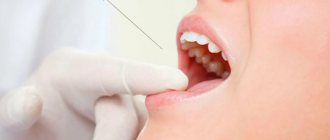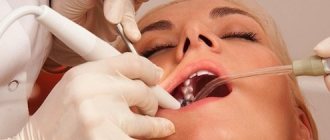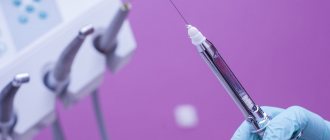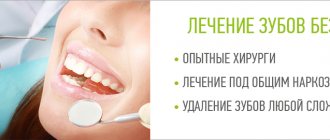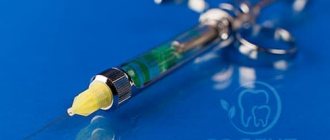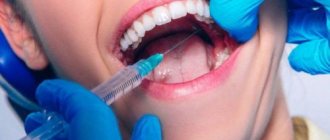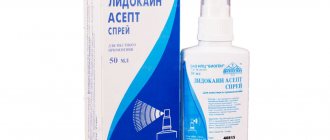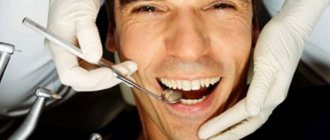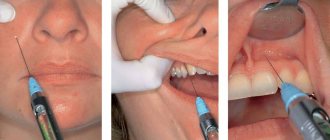Local anesthesia in dentistry: types and preparations
In therapeutic and surgical dentistry, various types and techniques of pain relief are used. These include conduction, intracanal, intraligamentous, etc. They differ in the place of application of the anesthetic and the characteristics of administration, as well as the duration of the effect.
In modern dental clinics, carpule anesthesia is used: the anesthetic is supplied in disposable carpules - cartridges in which painkillers are mixed in the required proportions. They are inserted into syringes with screw-on disposable needles. This makes it possible to ensure sterility, since the doctor does not need to open the containers - contact of the drug with air is excluded.
Conductor
Conduction anesthesia is designed to temporarily block the nerve that transmits the pain signal. This makes it possible to numb several teeth at once, since the sensitivity of a certain area of the jaw is lost. This type of anesthesia is used in cases where it is necessary to remove or treat 2-3 teeth located nearby. It is also used for operations on soft tissues. This anesthesia lasts for at least one and a half hours.
Application anesthesia
Application anesthesia is a type of non-injection anesthesia. Apply the product with your finger or a cotton swab to the selected area. Absorbing into soft tissues to a depth of 3 mm, the medicine can reduce their sensitivity for a short period of time. Most often, this method is used to make the injection painless.
There is another form of drug release - in the form of an aerosol. However, such drugs are used less frequently because there is a possibility of inhalation and the components entering the bloodstream.
Infiltration
There are two types: direct (introduction of the drug under the mucous membrane near the teeth), indirect (introduction into the surrounding tissues). In the first case, the effect is more local, in the second, a larger area is anesthetized.
Infiltration anesthesia is often used for the teeth of the upper jaw. The alveolar processes have a less dense structure, so anesthesia is effective within one hour. In most cases, this is quite enough to perform many procedures, such as treating deep caries, filling root canals, etc.
Intraligamentary
It is also called intraligamentous. This anesthesia differs in that when administering the drug, the doctor applies more pressure so that the drug can be distributed in the periodontal tissues and penetrate into the intraosseous space. This type of pain relief begins to work in less than a minute. However, its effect is short-lived: up to 30 minutes. The administration of the medicine is practically painless, and there is no numbness of the soft tissues. Intraligamentous anesthesia can be used for the extraction and preparation (grinding) of teeth.
Spongy
Also called intraosseous anesthesia, one of the most complex types. It is used when other methods demonstrate ineffectiveness or are impossible. Allows you to anesthetize the process of removing molars and perform interventions on the alveolar processes. The doctor first dissects the mucous membrane and makes a small hole in the bone tissue using a dental bur. Afterwards, a needle is inserted into it, and the anesthetic medicine is supplied to the spongy substance of the jaw. This anesthesia lasts for up to one hour.
General anesthesia in dentistry
General anesthesia in dentistry is used when long-term, serious treatment is necessary. This solution is relevant in cases that require the removal of several teeth at once, or complex interventions on the jaw. An indication for the use of anesthesia can also be a strong fear of the dentist and the upcoming manipulations. It is also advisable to resort to anesthesia if the patient cannot adequately interact with the doctor, for example, in the presence of a neuropsychiatric disease, epilepsy, etc.
An alternative to anesthesia is sedation: it can be used as a way to improve mood, relieve anxiety, and get rid of the fear of medical manipulation. The patient is conscious, but half asleep. Sedation promotes calm, psycho-emotional balance, and normal perception of the specialist’s actions. But this is not pain relief, so this method is combined with local anesthesia.
Modifications of intraosseous (spongy) anesthesia
1) a number of companies manufacture an injection needle with an external thread for spongy anesthesia, with a diameter slightly larger than the diameter of the bur. This needle is screwed into a bone canal formed by a bur, which ensures a tight fixation of the needle in the bone and allows the anesthetic to be injected into the bone tissue under significant pressure. 2) A special plastic cannula is inserted into the bone canal formed by the bur. A guard needle is advanced into the hole of the said cannula (the diameter of the carpule needle corresponds to the diameter of the cannula hole) and an anesthetic solution is injected into the bone tissue using a carpule injector under pressure. When performing intraosseous anesthesia in children, whose bone tissue is less dense than in adults, you can simply pierce the bone. The positive side of intraosseous (spongy) anesthesia is high-quality anesthesia using a relatively small amount (1.0-1.5 ml) of even a weak anesthetic - for example, 2% novocaine. Disadvantages : 1) complex execution technique; 2) the possibility of general complications occurring when the anesthetic solution enters the bloodstream. When a channel is formed in the bone, injury to the vessel is possible, and since the vessel in the bone tissue does not collapse, when administered, the anesthetic can easily enter the blood. To prevent this complication it is necessary: a) be sure to perform an aspiration test; b) slowly inject the anesthetic solution over 60-90 s. It must be admitted that these types of spongy anesthesia are not widely used due to the complex technique of implementation. This encourages the development and implementation of simpler methods of intraosseous anesthesia. We offer some of them.
When anesthesia is not used:
Contraindications to general anesthesia in dentistry are divided into relative and absolute. The first category includes exacerbation of chronic diseases, infectious diseases (Flu, herpes virus infection, etc.), pregnancy.
Anesthesia is absolutely contraindicated in the following cases:
- heart failure;
- serious kidney and liver diseases;
- endocrine disorders;
- respiratory problems, etc.
Therefore, preparation for general anesthesia is more serious: you will first need to undergo a comprehensive examination and consult with a general practitioner to assess your health and readiness for such a procedure.
Characteristics of anesthesia with the Quick Sleeper system:
- Instant action.
- Use of vasoconstrictors (up to 1:80,000 adrenaline) without the risk of necrosis.
- Highly effective for lower molars and teeth with pulpitis.
- There is no need for a palatal or lingual injection even for tooth extraction.
- There is no numbness of soft tissues.
- Minimum amount of subjective sensations. There is no paresthesia of the lips or tongue. There is a feeling of numbness in the tooth (“the tooth has become wooden”).
- Anesthesia from 2 to 8 teeth.
- High efficiency due to maximum coincidence of the injection target and the object of intervention, minimizing the resorptive effect.
- Low duration of effect, corresponding to the dose of anesthetic (15-20 minutes), and the ability to control its duration.
In publication [3], the author, using the iCATvision program, studied the depth of needle immersion during intraosseous dental anesthesia in various areas of the upper and lower jaws, and determined the optimal insertion depth for each area. In publication [8], the authors studied conduction and intraosseous, dental methods of anesthesia using articaine-containing anesthetics.
Intraosseous dental anesthesia is characterized by a faster rate of onset of pain relief (30-60 seconds) compared to conduction anesthesia (2-5 minutes), which makes it possible to begin treatment immediately after the injection. The introduction of 1.7-2.5 ml of Ultracain DS anesthetic during regional anesthesia provides pain relief for 40-60 minutes. Intraosseous injection of 0.2-0.4 ml Ultracain DS has an analgesic effect for 25-40 minutes. Direct evidence of vascular administration of the anesthetic is that in almost all cases of aspiration, blood was detected in the syringe body either in the form of noticeable traces or, more often, in full blood. Negative aspiration also indicates that the perforation was not completely successful, that is, the perforator did not enter the bone cell and sometimes the impossibility of anesthesia. Thus, when performing an intraosseous injection, the analgesic effect requires smaller doses of an anesthetic solution compared to conduction methods of anesthesia, which makes it possible to recommend intraosseous dental anesthesia for use in patients at an anesthetic risk group.
With conduction anesthesia, simultaneously with blockade of the inferior alveolar nerve, the lingual and buccal nerves are blocked. Intraosseous anesthesia does not affect the buccal and lingual nerves, there is no numbness of the soft tissues of the cheek and tongue. Observation of the dynamics of changes in blood pressure parameters during the conduction and intraosseous methods of administering the anesthetic solution did not reveal statistically significant differences.
Contraindications to anesthesia in dentistry
Anesthesia in dentistry has some contraindications: allergic reactions to anesthetic components, individual intolerance. Side effects are mainly associated with the components of the solutions - vasoconstrictors, or vasoconstrictors, as well as stabilizers and preservatives. Therefore, the doctor is especially careful when choosing an anesthetic for patients with chronic diseases: endocrine, cardiovascular. Preference is given to drugs in which vasoconstrictor components are present in minimal quantities or are absent altogether.
To determine an allergic reaction, a preliminary examination by an allergist may be required. Based on the results of diagnosis and allergy testing, the specialist selects a safe local anesthetic. If reactions are observed to all local agents, general anesthesia may be used.
The use of intraosseous dental methods of pain relief using computer injectors
The use of intraosseous dental methods of pain relief using computer injectors requires clarification of the choice of local anesthetic, its quantity, distribution in tissues, time of onset and duration of anesthesia. The electronic Quick Sleeper system (Dental Hi Tec, France) provides ease of intraosseous dental anesthesia, thereby greatly facilitating everyday work. The exclusive PAR (Permanent Analysis of Resistance) system ensures uniform delivery of anesthetic regardless of tissue density and eliminates the risk of carpule breakage. Thanks to intraosseous dental anesthesia, the most complex clinical case becomes extremely simple. System composition: base unit, foot pedal for supplying anesthetic and aspiration sample, injector in the form of a pen with a cartridge for a standard anesthetic cartridge with a disposable needle. Cortical penetration, one-step anesthesia procedure. Electronic control of perforation and injection parameters, which prevents painful injection. The injector is shaped like a pen, so there is no need for force or pressure during injection of the anesthetic. Unlike other devices, there is no need for special consumables or replacement of various parts that increase the cost of operating the equipment. With the advent of this technology, intraosseous dental anesthesia changed its name to transcortical. The transcortical anesthesia technique is based on penetration through the cortical plate and injection of an anesthetic in close proximity to the tooth in need of treatment. The procedure is simple and does not take time, since treatment can begin immediately after the injection. The Quick Sleeper system offers two programmed anesthetic delivery rates. This ensures that the speed is appropriate for each clinical case. An additional “low” mode is used to anesthetize particularly sensitive areas, such as the frenulum of the tongue, or when working with children. Injections are carried out under constant control, are easy to perform, do not cause pain or damage tissue, and allow the doctor to focus only on the injection point.
Indications for use
Situations in which this method of pain relief is recommended include:
- Treatment of caries in various forms, including complicated ones;
- Extraction of dental elements;
- Cleaning of periodontal pockets (curettage);
- Installation of prosthetic structures, including implants;
- Purpose of flap surgery.
As practice shows, the main factor determining the need for intraseptal anesthesia is the ineffectiveness of alternative methods of pain relief, as well as operations characterized by opening the bone structure of the jaw.
The following are defined as limiting medical indications identified at the diagnostic stage:
- Inflammatory processes developing in the structure of the mucous tissues of the oral cavity;
- Identified osteomyelitis and periodontitis, including acute and chronic forms;
- Development of maxillary periostitis.
Infiltration anesthesia according to Vishnevsky
Infiltration anesthesia according to Vishnevsky is a method that combines the features of infiltration and conduction anesthesia (the transmission of nerve impulses is also blocked). During the procedure, a syringe and scalpel are used. The drug is administered in layers, after each injection of the anesthetic, cutting the subsequent layer of tissue.
Infiltration anesthesia with novocaine according to Vishnevsky has the following advantages (since each stage of action can be controlled):
- the risk of intoxication of the body is eliminated;
- if bleeding occurs, it can be quickly stopped;
- the likelihood of damage to nerves and blood vessels is minimized.
Advantages and disadvantages
A feature of the method under consideration is the distribution of the solution in two directions at once:
- Into the bone marrow structure located in the area of the alveolar sockets - blocking the pulp and root nerve endings.
- Into the blood vessels located in the bone marrow and periodontium - ensuring the distribution of anesthetic elements.
Intraseptal anesthesia provides blocking of both soft and bone tissues, promoting bleeding of the periodontium, which increases the achieved effect. The technology is characterized by the presence of both advantages and disadvantages. Positive aspects include:
- Deeper pain relief compared to standard anesthesia methods;
- Accelerating the rate of blood clotting, facilitating surgical intervention required in the treatment of periodontal tissues, implantation, etc.;
- Minimum duration of action - the effect is achieved in a minute;
- Low likelihood of complications associated with the injection;
- Preventing infection of healthy oral tissues.
Among the negative aspects inherent in intraseptal anesthesia, the following are noted:
- Limited radius of the area of anesthesia - as a rule, within two elements of the dentition, as well as adjacent tissues;
- Short duration of action - the effect lasts for 20-25 minutes, after which the active substance is completely absorbed;
- Unpleasant taste that occurs when the drug enters the oral cavity.
The final decision on the choice of technique is made based on the clinical picture.
